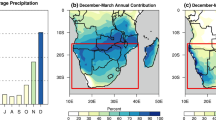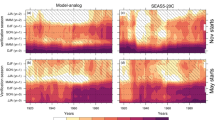Abstract
Based on an analysis of hindcasts from a seasonal forecast system, complemented by the analysis of a large ensemble of AMIP simulations, possible causes for skillful prediction of the winter Arctic Oscillation (AO) on a seasonal time-scale are analyzed. The possibility that the recent increase in AO skill could be due to model improvements, or due to changes in the persistence characteristics of the AO, is first discounted. The analysis then focuses on exploring the possibility that the recent increase in prediction skill in AO may be due to sampling variations or could have physical causes. Temporal variations in AO skill due entirely to sampling alone cannot be discounted as this is a fundamental constraint on verifications over a short time-series. This notion is supported from theoretical considerations, and from the analysis of the temporal variations in the perfect model skill where substantial variations in skill due to sampling alone are documented. As for the physical causes, the analysis indicates possible links in the prediction skill of AO with the SST forcing from the tropics, particularly related to the SST variations associated with the Trans-Niño Index (TNI). Interannual and low frequency variations in the TNI could have contributed to similar temporal variations in AO skill. For example, a dominance of central Pacific El Niño events after 2000 (a reflection of low-frequency variations in TNI) coincided with an increase in the prediction skill of AO. The analysis approach and results provide an avenue for further investigations; for example, model simulations forced with the SST pattern associated with the TNI, to establish or reaffirm causes for AO skill.











Similar content being viewed by others
References
Alexander MA, Blade I, Newman M, Lanzante JR, Lau N-C, Scott JD (2002) The Atmospheric bridge: the influence of ENSO teleconnections on Air–Sea interaction over the Global Oceans. J Clim 15:2205–2231
Ashok K, Behera SK, Rao SA, Weng H, Yamagata T (2007) El Niño Modoki and its possible teleconnection. J Geophys Res Oceans 112:C11007. https://doi.org/10.1029/2006JC003798
Barnston AG, Chelliah M, Goldengerg SB (1997) Documentation of a highly ENSO-related SST region in the equatorial Pacific. Atmos Ocean 35:367–383
Bretherton CS, Battisti DS (2000) An interpretation of the results from atmospheric general circulation models forced by the time history of the observed sea surface temperature distribution. Geophys Res Lett 27:767–770
Butler A et al (2016) The Climate-system Historical Forecast Project: do stratosphere-resolving models make better seasonal climate predictions in boreal winter? Q J R Meteorol Soc 142:1413–1427
Dunstone N, Smith D, Scaife A, Hermanson L, Eade R, Robinson N, Andrews M, Kight J (2016) Skilful predictions of the winter North Atlantic Oscillation one year ahead. Nat Geosci 9:809–814
Eade R, Smith D, Scaife E, Wallace N, Dunstone L, Hermanson, Robinson N (2014) Do seasonal-to-decadal climate predictions under-estimate the predictability of the real world? Geophys Res Lett 41:5620–5628. https://doi.org/10.1002/2014GL061146
Feldstein SB (2000) The timescale, power spectra, and climate noise properties of teleconnection patterns. J Clim 13:4430–4440
Guan C, McPhaden MJ (2016) Ocean process affecting the twenty-first-century shift in ENSO SST variability. J Clim 29:6861–6879. https://doi.org/10.1175/JCLI-D-15-0870.1
Hoerling MP, Kumar A, Zhong M (1997) El Niño, La Nia and the nonlinearity of their teleconnections. J Clim 10:1769–1786
Hu Z-Z, Kumar A, Hunag B, Xue Y, Wang W, Jha B (2011) Persistent atmospheric anomalies in the North Atlantic from summer 2009-summer 2010. J Clim 24:-5812–5830
Janowiak JE, Xie P (1999) CAMS-OPI: A global satellite-rain gauge merged product for real time precipitation monitoring application. J Clim 12:3335–3342
Kalnay E et al (1996) The NCEP/NCAR 40-year reanalysis project. Bull Am Meteorol Soc 77:437–471
Kang D et al (2014) Prediction of the Arctic Oscillation in boreal winter by dynamical seasonal forecast systems. Geophys Res Lett 41:3577–3585. https://doi.org/10.1002/2014GL060011
Kirtman B, Pirani A (2009) The state of the art of seasonal prediction—Outcomes and recommendations from the first World Climate Research Program workshop on seasonal prediction. Bull Am Meteorol Soc. https://doi.org/10.1175/2008BAMS2707.1
Kumar A (2009) Finite sample and uncertainty estimates for skill measures for seasonal prediction. Mon Wea Rev 137:2622–2631. https://doi.org/10.1175/2009MWR2814.1
Kumar A, Hoerling MP (2000) Analysis of a conceptual model of seasonal climate variability and implications for seasonal predictions. Bull Am Meteor Soc 81:255–264
Kumar A, Wang H (2015) On the potential of extratropical SST anomalies for improving climate predictions. Clim Dyn 44:2557–2569
Kumar A, Peng P, Chen M (2014a) Is there a relationship between potential and actual shill? Mon Wea Rev 142:2220–2227
Kumar A, Jha B, Wang H (2014b) Attribution of SST variability in global Oceans and the role of ENSO. Clim Dyn 43:209–220
Kushnir Y, Robinson WA, Chang P, Robertson AW (2006) The physical basis for predicting Atlantic sector seasonal-to-interannual climate variability. J Clim 19:5949–5970
Lau N-C (1981) A diagnostic study of recurrent meteorological anomalies appearing in a 15-year simulation with a GFDL general circulation mode. Mon Wea Rev 109:2287–2311
Lee T, McPhaden MJ (2010) Increasing intensity of El Niño in the central-equatorial Pacifc. Geophys Res Lett 37:L14603. https://doi.org/10.1029/2010GL044007
Limpasuvan V, Hartmann DL (1999) Eddies and the annular modes of climate variability. Geophys Res Lett 26:3133–3136
Mantua NJ, Hare SR, Zhang Y, Wallace JM, Francis RC (1997) A Pacific interdecadal climate oscillation with impacts on salmon production. Bull Am Meteorol Soc 78:1069–1080
Mehta VM, Suarez MJ, Manganello JV, Delworth TL (2000) Oceanic influence on the North Atlantic Oscillation and associated northern hemisphere climate variations: 1959–1993. Geophys Res Lett 27:121–124. https://doi.org/10.1029/1999GL002381
National Research Council (2010) Assessment of intraseasonal to interannual climate prediction and predictability, pp 192. National Academies Press, Washington, DC (ISBN-10:0–309-15183-X)
Rayner NA, Parker DE, Horton EB, Folland CK, Alexander LV, Rowell DP, Kent EC, Kaplan A (2003) Global analyses of sea surface temperature, sea ice, and night marine air temperature since the late nineteenth century. J Geophys Res 108:2–1. https://doi.org/10.1029/2002JD002670
Reynolds WR, Rayner NA, Smith TM, Stokes DC, Wang W (2002) An improved in situ and satellite SST analysis for climate. J Clim 15:1609–1625
Riddle EE, Butler AH, Furtado JC, Cohen JL, Kumar A (2013) CFSv2 ensemble prediction of the wintertime Arctic Oscillation. Clim Dyn 41:1099–1116. https://doi.org/10.1007/s00382-013-1850-5
Robertson AW (2001) Influence of ocean-atmosphere interaction on the Arctic Oscillation in two general circulation models. J Clim 14:3240–3254
Robertson AW, Mechoso CR, Kim Y-J (2000) The influence of Atlantic sea surface temperature anomalies on the North Atlantic Oscillation. J Clim 13:122–138
Rodwell MJ, Rowell DP, Folland CK (1999) Oceanic forcing of the winter North Atlantic Oscillation and European climate. Nature 398:320–323
Saha S et al (2010) The NCEP climate forecast system reanalysis. Bull Am Meteorol Soc 91:1015–1057. https://doi.org/10.1175/2010BAMS3001.1
Saha S et al (2014) The NCEP climate forecast system version 2. J Clim 27:2185–2208. https://doi.org/10.1175/JCLI-D-12-00823.1
Scaife AA et al (2014) Skillful long-range prediction of European and North American winters. Geophys Res Lett 41:2514–2519. https://doi.org/10.1002/2014GL059637
Scaife AA et al (2017) Tropical rainfall, Rossby waves and regional winter climate predictions. Q J R Meteorol Soc. https://doi.org/10.1002/qj.2910
Shi W, Schaller N, MacLeod D, Palmer TN, Weisheimer A (2015) Impact of hindcast length on estimates of seasonal climate predictability. Geophys Res Lett 42:1554–1559. https://doi.org/10.1002/2014GL062829
Stockdale T, Molteni F, Ferranti L (2015) Atmospheric initial conditions and predictability of the Arctic Oscillation. Geophys Res Lett 42:1173–1179
Trenberth KE, Stepaniak DP (2001) Indices of El Niño evolution. J Clim 14:1697–1701
Trenberth EK, Branstrator GW, Karoly D, Kumar A, Lau N-C, Ropelewski C (1998) Progress during TOGA in understanding and modeling global teleconnections associated with tropical sea surface temperatures. J Geophys Res 107(C7):14291–14324
Watanabe M, Kimoto M (1999) Tropical-extratropical connection in the Atlantic atmosphere-ocean variability. Geophys Res Lett 26:2247–2250
Weisheimer A, Schaller N, O’Reilly C, MacLeod DA, Palmer TN (2017) Atmospheric seasonal forecasts of the twentieth century: multi-decadal variability in predictive skill of the winter North Atlantic Oscillation (NAO) and their potential value for extreme event attribution. Q J R Meteorol Soc 143:917–926
Wen C, Kumar A, Xue Y (2014) Factors contributing to uncertainty in Pacific Decadal Oscillation index. Geophys Res Lett 41:7980–7986. https://doi.org/10.1002/2014GL061992
Zhang W, Wang L, Xiang B, Qi L, He J (2015) Impacts of two types of La Niña on the NAO during boreal winter. Clim Dyn 44:1351–1366
Acknowledgements
We would like to thank Michelle L'Heureux, Peitao Peng and two anonymous reviewers for providing insightful comments that led to improvements in the final version of the manuscript.
Author information
Authors and Affiliations
Corresponding author
Electronic supplementary material
Below is the link to the electronic supplementary material.
Rights and permissions
About this article
Cite this article
Kumar, A., Chen, M. Causes of skill in seasonal predictions of the Arctic Oscillation. Clim Dyn 51, 2397–2411 (2018). https://doi.org/10.1007/s00382-017-4019-9
Received:
Accepted:
Published:
Issue Date:
DOI: https://doi.org/10.1007/s00382-017-4019-9




